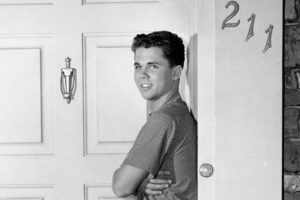 I’ve written columns about “Leave It to Beaver” before, so when I heard the heartbreaking news that Tony Dow had died I wondered if perhaps I shouldn’t head down that road again.
I’ve written columns about “Leave It to Beaver” before, so when I heard the heartbreaking news that Tony Dow had died I wondered if perhaps I shouldn’t head down that road again.
But how could I not write about the cutest imaginary boyfriend in the whole wide world?
I wasn’t quite three years old when “Leave It to Beaver” premiered in 1957, so I likely didn’t start watching until the early 1960s. It was love at first sight when Wally Cleaver, hands shoved into the pockets of his perfectly-ironed khakis, strolled onto the screen of my family’s black-and-white console television set. He was a dreamboat, with strong shoulders and narrow hips and curly hair and those pale, pale eyes. (Were they blue or were they green? Who cared? Wally’s eyes were just as beautiful as the rest of him.) He was also smart and kind and dependable and hard-working and self-effacing. And to top it off, he was a gifted athlete AND a Boy Scout. What girl in her right mind wouldn’t want him for a boyfriend?
Lucky for me and for the millions of other girls who had a crush on Wally, “Leave It to Beaver” lives on in reruns, even though the series ceased production in 1963. The Cleaver family and the town of Mayfield, state unknown, are forever with us. As I searched for streaming services that carry the show—Peacock and the Roku Channel are two that do—and settled in to watch after learning of Tony Dow’s passing, I began to ponder what gives the show its staying power.
Partly, it’s because we’re still in awe that June was able to keep a spotless home while dressed in pearls and high heels. We still shake our head in wonder that Ward didn’t even loosen his necktie when he got home after a hard day at the office. We marvel, perhaps with a good deal of envy, that families once sat down together at the dining table to a cooked-from-scratch supper, complete with candles and a tablecloth and linen napkins.
One of the major appeals of “Leave it to Beaver” is that it was told through the eyes of the kids. Beaver and Wally, not Mom and Dad, were the ones always getting into hot water—from losing library books to flooding their en suite bathroom (though I’m pretty sure en suite wasn’t a term back in those days) to car troubles to job troubles to girl troubles—and who, wonder of wonders, always figured a way out in just under half an hour.
The scripts were good. The acting was good. And the fact that every episode had an obvious but gentle take-away was a good thing, too, especially when the moral of the story was delivered by an ever-serious Ward Cleaver, sitting on the corner of his desk in his bookshelf-lined den.
I don’t recall my own kids watching “Leave It to Beaver” when they were children and I seriously doubt that my grandkids watch it either. That’s a shame. Though that world is foreign to them in many ways—and I’m not talking just about clothes and cars and expressions like “Gee, whizz”—the problems the Cleaver brothers faced are problems kids still face. Except that now we must add to the list constantly-distracted parents and low teacher morale and street drugs and prescription drugs and the never-ending barrage of social media and an overabundance of junk food and, oh yeah, school shootings that happen pretty much every week.
For me, Tony Dow’s passing puts an exclamation mark on the death of innocence and wholesomeness and happy endings. But I’m thankful that the wonders of technology allow me to travel back in time whenever I wish and pretend I’m the girl Wally Cleaver wants to take to the Mayfield Junior High School dance.
(August 6, 2022)